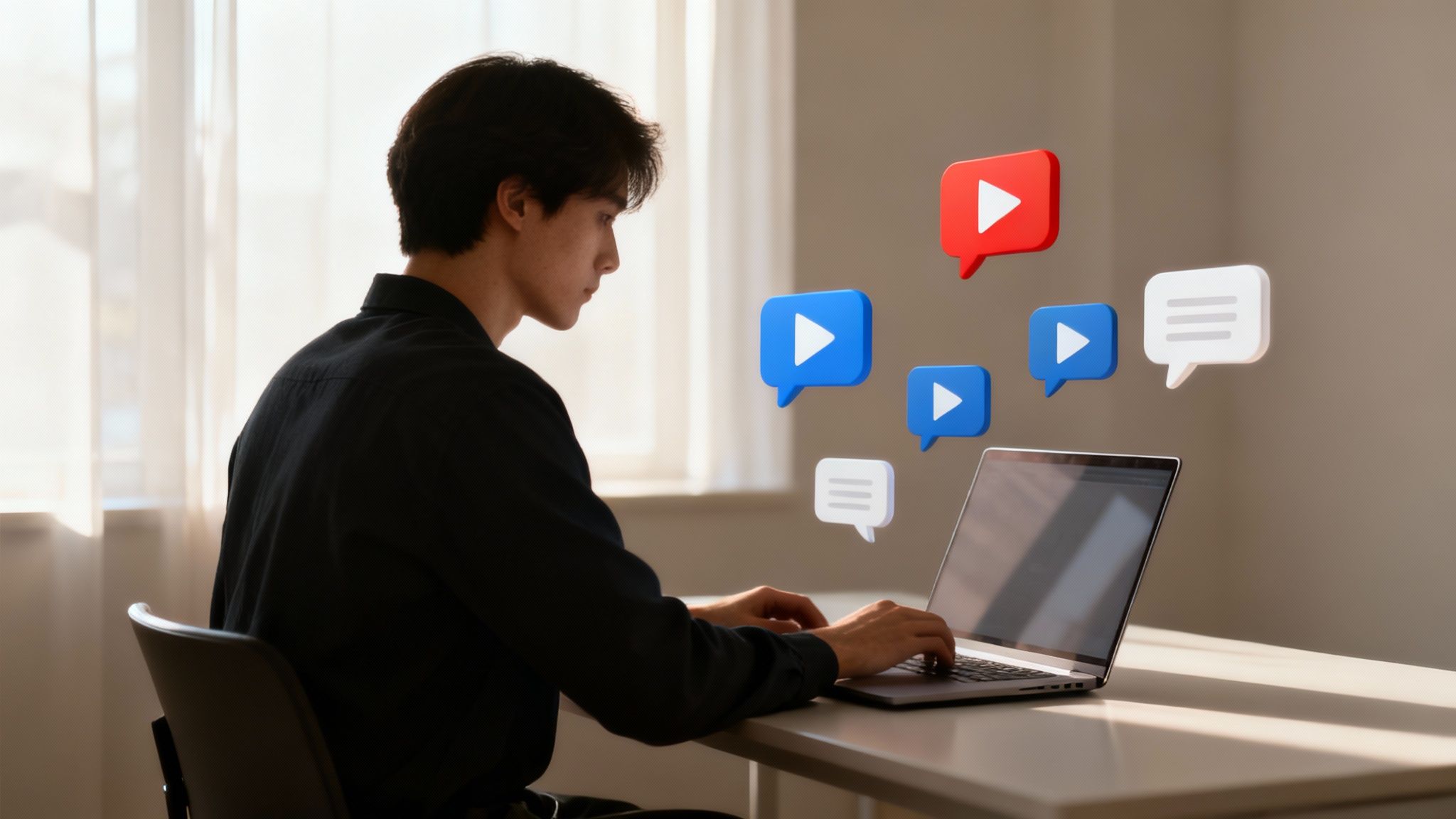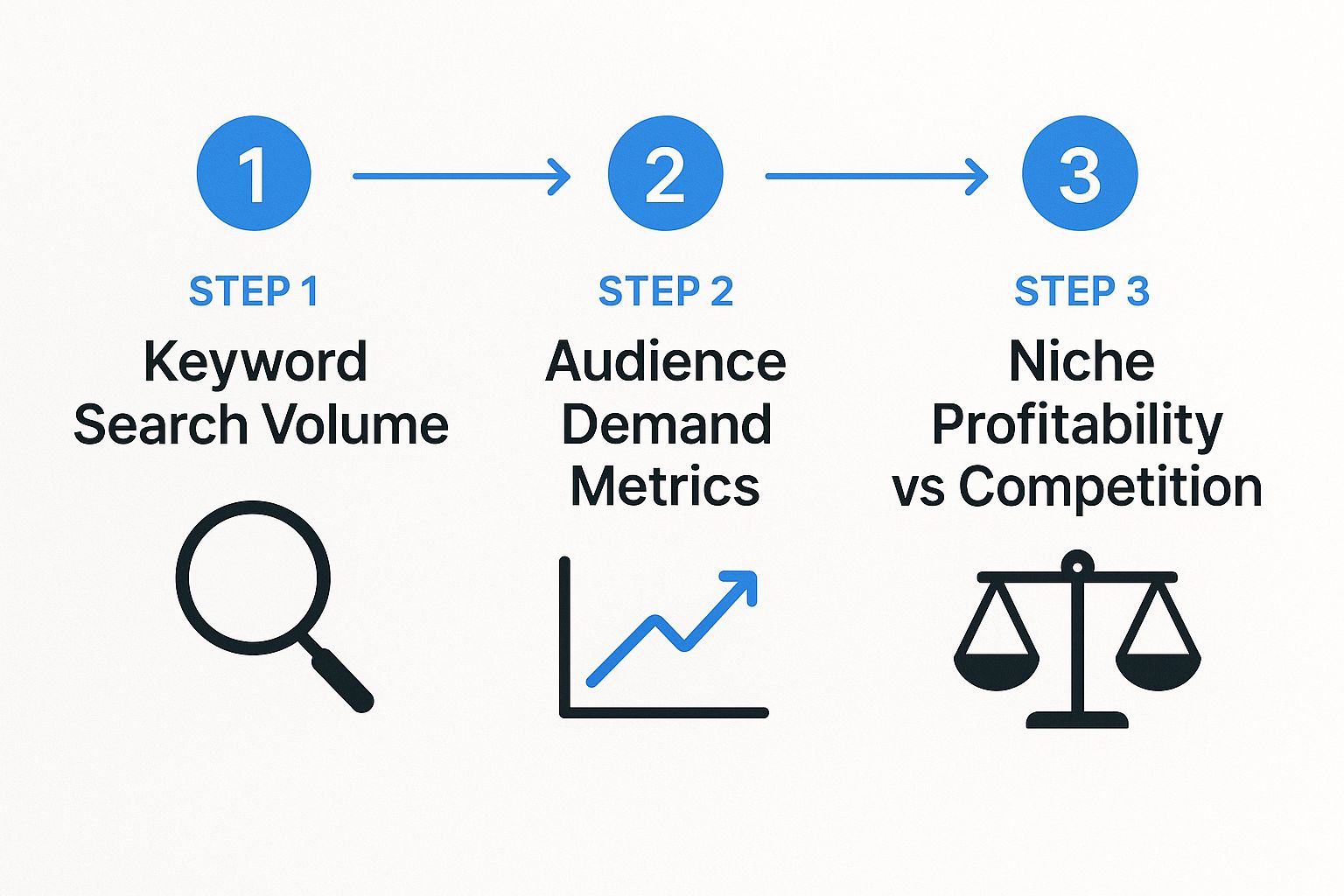How to Start a Faceless YouTube Channel: Easy Step-by-Step Guide
Ready to jump into the world of faceless YouTube channels? It really boils down to four key moves: picking a profitable niche, whipping up content using stock footage and AI voiceovers, optimizing your videos so people actually find them, and building a loyal community without ever showing your face. The whole process is less about fancy camera gear and more about smart content strategy, making it a wide-open field for anyone with a great idea.
Why Faceless YouTube Channels Are Taking Over

If you've spent any time on YouTube recently, you’ve probably seen the shift. The classic, personality-led vlog isn't going anywhere, but it’s definitely sharing the stage with a new kind of creator—one you’ll never actually see.
Faceless channels are blowing up, and it’s way more than a temporary trend. We're seeing a fundamental change in what viewers are looking for. People are prioritizing high-quality information and a great story over seeing the creator's face on screen.
It's easy to see the appeal. For a lot of would-be creators, the thought of being on camera is a massive roadblock. You worry about how you look, performance anxiety kicks in, and privacy becomes a real concern. Faceless channels completely sidestep that problem.
This anonymity is a game-changer for experts, introverts, and any creative who just prefers working behind the scenes. It lets them share their passion and knowledge without having to become a public figure, putting all the focus back where it belongs: on the quality of the content.
The Rise of Creator Anonymity
The explosion in faceless channels is thanks to technology becoming so much more affordable and easy to use. As of 2025, these channels are seeing a huge surge in popularity because they don't require expensive equipment or on-camera confidence.
This is all fueled by tools like AI-generated voiceovers and text-to-speech software, which let creators produce professional-sounding audio without ever speaking into a microphone. You can dig deeper into this trend and see which niches are paying the most over on nexlev.io.
How AI Levels the Playing Field
This tech shift has really democratized content creation. Tools like ClipShort make it possible for anyone with a solid idea to produce videos that look and sound professional. What used to take a skilled video editor and pricey software can now be done with just a few clicks.
This frees you up to focus on what actually moves the needle:
- Storytelling: Weaving narratives that grab viewers from the very first second.
- Information Value: Delivering content that teaches, entertains, or inspires.
- Consistency: Pumping out a steady flow of videos to build that all-important momentum.
By using these tools, you can strategically place yourself right in the middle of this growing movement. This isn't just about hiding your face; it’s about embracing a new, incredibly efficient, and powerful way to build a successful YouTube channel. For anyone looking to really hit the ground running, figuring out how to grow on YouTube Shorts is a crucial piece of the puzzle.
Choosing Your Profitable Faceless Niche
The single most important decision you'll make when figuring out how to start a faceless YouTube channel is picking your niche. Seriously, this isn't just about what topic you'll cover; it's the entire foundation for your content, your audience, and how you'll eventually make money. Get this right from day one, and you're building on solid ground.
A profitable niche is the sweet spot where genuine audience demand, your own passion or expertise, and a clear path to revenue all meet. Instead of just chasing whatever's trending this week, you need to think about sustainability. Ask yourself, "Can I realistically create 100 videos about this without completely burning out?"
The good news is that many of the most successful faceless channels thrive in categories that don't need a human face to deliver value. Think about finance explainers, guided meditations, deep dives into history, or tech tutorials. These niches work because the information itself is the star of the show—all it needs is strong narration and some compelling visuals to back it up.
Finding Your Niche Sweet Spot
So, how do you find a niche that actually works? It comes down to balancing three things: keyword search volume, genuine audience demand, and the level of competition. This is less about guesswork and more about smart research.

As you can see, the process starts with figuring out what people are actively searching for. From there, you validate that a real audience exists for that topic, and finally, you weigh whether the potential payoff is worth going up against the existing competition.
The profit potential in some of these faceless niches is massive. Just look at the DIY and crafts space—channels like 5-Minute Crafts, with its 81 million subscribers, prove you don't need to be on camera to build an empire. Storytelling channels like Be.Busta, which focuses on horror stories, can also pull in serious income from multiple revenue streams. You can dig into more profitable faceless channel ideas and their earnings potential to see just how wide the opportunities are.
Before we dive into research methods, let's look at some of the most popular niches to get your ideas flowing. This table breaks down what's working right now and what it takes to succeed in each.
Popular Faceless YouTube Niches and Their Monetization Potential
| Niche | Content Style | Primary Skill | Monetization Potential |
|---|---|---|---|
| Finance & Investing | Whiteboard animations, screen recordings, stock footage explainers | Clear communication, data analysis | Very High |
| Meditation & Wellness | Calming visuals (nature, abstract), soothing voiceover, ambient music | Audio production, scriptwriting | High |
| History & Documentary | Archival footage, maps, animated timelines, deep-dive narration | Research, storytelling | Medium to High |
| Tech & Software Tutorials | Screen recordings, step-by-step guides | Technical expertise, clear instruction | High |
| Gaming (No Commentary) | Long-form gameplay, "let's plays," cinematic compilations | Gaming skill, video editing | Medium |
| DIY & Life Hacks | Top-down shots of hands, quick cuts, text overlays | Creativity, video editing | Very High |
This is just a starting point, of course. The key is to find where your skills and interests align with one of these proven models.
Actionable Research Methods
Don't just throw a dart at a board and hope it lands on a good idea. You need to use real data to validate your ideas and find that perfect intersection of passion and audience interest. Here’s a simple way to get started:
- Brainstorm Your Passions: First, just make a list. What subjects do you genuinely love talking or learning about? This could be anything from ancient history to minimalist home organization. Your authentic interest will shine through.
- Do Some Keyword Recon: Use free tools like Google Trends or even YouTube’s own search bar to see what people are looking for. As you type, see what autocomplete suggests—that’s a goldmine. Look for specific, long-tail keywords like "beginner stoicism exercises" instead of a broad term like "philosophy."
- Analyze the Competition: Search your topic on YouTube. Are the top channels run by massive media companies, or is there room for a new voice? A great sign is finding channels with high view counts but inconsistent upload schedules. That’s your opening.
Remember, the goal isn’t to find a completely undiscovered, magical topic. The goal is to find a proven topic that you can tackle with a unique angle, better quality, or simply more consistency than what's already out there. Your unique perspective is your biggest advantage.
Building Your AI Content Machine

Okay, you've locked in a killer niche. What's next? It's time to build the engine that will actually pump out your videos. This is where most aspiring creators crash and burn—they have no system.
A repeatable workflow is the only way to produce quality faceless videos consistently without getting overwhelmed. Forget about complicated software or spending weeks learning to edit. We're talking about a smart, AI-driven process.
The whole thing boils down to three simple stages: scripting, voiceover, and video assembly. By plugging the right AI tool into each stage, you turn what used to be a massive headache into a streamlined, almost paint-by-numbers process. This system is built for speed and scale, letting you go from a raw idea to a finished video in a tiny fraction of the usual time.
Let's make this real. Imagine we're creating a five-minute video called "5 Stoic Principles for a Calmer Mind" for a brand-new philosophy channel.
From Blank Page to Polished Script
Every good video starts with a solid script. It's the skeleton. But staring at a blank document is creative quicksand. This is where you bring in a tool like ChatGPT to do the initial heavy lifting.
The trick is to give it specific, detailed instructions. Don't just ask for "a script." You need to direct it like a pro.
Here’s a prompt that actually works:
- Role: Act as a scriptwriter for a faceless YouTube channel about practical philosophy.
- Topic: "5 Stoic Principles for a Calmer Mind."
- Tone: Sound authoritative but friendly. Keep it calm and educational.
- Structure: Write a script for a 5-minute video. Start with a strong hook, give me five clear points with short explanations and modern examples, and wrap up with a call to action asking people to subscribe.
This gets you a 90% finished draft in seconds. Your job is to come in and add the final 10%—your unique voice, a few tweaks, and a final polish.
Creating a Voice That Connects
With the script done, you need a voice. For a faceless channel, the narration is everything. It builds trust and keeps people listening. Thankfully, AI voice generators like ElevenLabs or Murf.AI are shockingly good now.
The real game-changer here isn’t just the quality of the voices, but the control you have. You can tweak the pacing, add pauses for dramatic effect, and adjust the inflection. The end result sounds like a real person, not the clunky text-to-speech from a few years ago.
You just copy your final script, paste it into the tool, pick a voice that fits your channel’s vibe (for our philosophy video, a deep, calm voice would be perfect), and hit render. Boom. You’ve got a professional-grade audio file ready to go.
Turning Words and Audio into a Finished Video
This is where the magic really happens. With an AI video generator like ClipShort, you can take your script and voiceover and let the AI build the video for you. No editing experience required.
It’s an incredibly simple workflow:
- Upload Your Assets: Just give it your script and the voiceover file you just made.
- Let the AI Work: ClipShort scans your script and automatically pulls relevant, high-quality stock footage and images for every single line. For the Stoicism video, it would probably find clips of peaceful nature scenes, people thinking, or cool abstract visuals.
- Add Killer Captions: It also transcribes your audio and slaps on animated, easy-to-read captions. This is non-negotiable for holding attention, especially for Shorts.
- Add the Final Polish: You can easily drop in background music, sprinkle in some emojis, or swap out any of the AI-chosen clips if you have something better in mind.
This entire process replaces what used to be hours of painstaking manual editing. This is how you build a system that can scale, letting you pump out several high-quality videos every single week without breaking a sweat.
Mastering Scripts and Voiceovers
On a faceless channel, your words and your voice do all the heavy lifting. They aren't just there to support the visuals—they are the personality. They build the authority and give someone a reason to stick around.
I've seen so many scripts that look great on paper but just fall completely flat when spoken. This is a classic rookie mistake. You have to learn to write for the ear, not the eye.
What does that mean? It means using simpler language and shorter sentences. It means adopting a conversational tone that feels like you're talking to a friend. A great way to check this is to read your script out loud while you write. Does it flow naturally? Or does it sound like you're reciting a textbook? If it's the latter, it's time to simplify.
Think about it: people decide whether to keep watching a video within the first 3-5 seconds. Your intro has to hit hard and fast. Get straight to the value, ask a question that makes them think, or drop a surprising fact they can't ignore.
Crafting a Compelling Narrative
Once you've grabbed their attention, you have to keep it. A simple but incredibly effective structure for faceless videos is the classic "Hook, Content, Summary" model. It just works.
- The Hook: A powerful opener that grabs attention and makes a clear promise.
- The Content: This is where you deliver on that promise. Lay out your points, tell a story, or walk them through the steps. Use transitional phrases to guide the listener smoothly from one idea to the next.
- The Summary & CTA: Quickly recap the most important takeaways and then tell the viewer exactly what you want them to do next. "Subscribe for more," or "check out the link in the description."
This isn't just about listing facts. You're telling a story. Even a dry tutorial on software can have a narrative arc—the problem, the struggle, and the solution you're offering. That's what creates an emotional connection and keeps people glued to the screen.
Directing the Perfect AI Voice
With your script polished, it’s time to bring it to life with an AI voiceover. Choosing the right voice is absolutely critical. A high-energy, fast-paced voice is going to feel jarring and wrong for a guided meditation channel. You have to match the voice's tone and style to your niche and brand.
The real secret to making an AI voice sound human isn't just picking a good one—it's learning how to direct it. Modern tools like ElevenLabs or Murf.AI give you an incredible amount of control to add pauses, tweak inflections, and emphasize certain words.
Use these features strategically. Add a short pause right after you make an important point to let it sink in. Change the pitch slightly when you ask a question to make it more engaging. These little tweaks are what transform a robotic narration into a genuinely trustworthy and listenable voice.
Getting this right is also a huge part of learning how to make viral YouTube Shorts, where vocal pacing is everything.
Growing and Monetizing Your Channel

Making great videos is just one piece of the puzzle. The real engine for a successful faceless channel is a smart growth and monetization strategy. Without a plan to get your videos discovered, even the best content will just sit there, collecting digital dust.
This is where you have to get serious about YouTube SEO.
Think of YouTube as the world's second-biggest search engine. Your titles, descriptions, and tags are how you tell its algorithm what your video is about and who should see it. A lazy title like "History Facts" is basically invisible. But something specific and keyword-focused like "5 Shocking Roman Scandals They Never Taught You in School"? Now you're getting somewhere.
Your description is more than a summary—it's prime SEO real estate. Pack the first two sentences with your most important keywords, since that's what everyone sees in search results. Below that, write a full paragraph that expands on the video's value, weaving in related keywords and phrases naturally.
Thinking Beyond AdSense
Hitting the requirements for the YouTube Partner Program is a huge milestone, but for a faceless channel, AdSense revenue should just be the starting line. If you rely only on ad money, you're at the mercy of algorithm changes and fluctuating ad rates.
The real money is in building a business around your content. This is how you turn a side project into a real enterprise. It’s less about the niche and more about a smart, multi-pronged business strategy.
For example, a channel like Make Money Matt, which focuses on software tutorials, is estimated to make around $10,000 a month from ads alone. But the real genius is how it integrates other income streams, turning a simple channel into a potential million-dollar business. You can find more insights on how top creators build their income streams on YouTube.
True financial stability comes from owning your revenue sources. Your YouTube channel is the top of the funnel, the asset that attracts an audience. The next step is to guide that audience toward offers you control.
Building these extra income streams doesn't have to be complicated. Just start with one or two that feel like a natural fit for your content and your audience.
Diversifying Your Revenue Streams
Here are three of the most effective monetization models for faceless creators. You can build all of these without ever showing your face on camera.
- Affiliate Marketing: This is usually the easiest place to start. If you run a channel on tech tutorials, you can drop affiliate links for the software you review. A book summary channel can link to Amazon. The trick is to only promote products you actually use and trust—your audience will see right through anything else.
- Selling Digital Products: This is where your profit margins can really soar. If you teach personal finance, you could sell a custom budget spreadsheet or a short ebook. A channel with guided meditations could sell audio packs. You create the product once and can sell it forever.
- Brand Sponsorships: Once you start getting traction, brands will find you. They'll pay you to mention their product or service in your videos. For a faceless channel, this is super easy to do with a simple voice-over mention or a graphic overlay.
By mixing and matching these strategies, you create a much more stable business where each income stream supports the others. And if you're all-in on short-form content, it's a good idea to learn the specifics of how to monetize YouTube Shorts, since the rules are a bit different from long-form videos.
Common Questions About Faceless Channels
Jumping into the world of faceless content creation usually brings up a few questions right off the bat. It's totally normal. Most people wonder about the same things, like how you actually make money or build a real audience when nobody ever sees your face.
Let's clear the air on some of the biggest questions people have before they get started.
Can Faceless Channels Really Get Monetized?
Absolutely. There's a persistent myth that YouTube won't monetize channels where the creator isn't on camera, but that's just not true.
A faceless YouTube channel is monetized through the YouTube Partner Program under the exact same rules as any other channel. YouTube cares about the originality and value of your content, not whether your face is in it.
As long as you hit the standard requirements—1,000 subscribers and 4,000 watch hours—and your videos follow the community guidelines, you're good to go. Your path to getting paid is built on great scripts, engaging visuals, and a solid content strategy.
The key takeaway here is simple: your content's value is what matters. A well-researched documentary or a relaxing guided meditation provides huge value without ever needing a talking head.
Do I Need Expensive Software to Start?
Not at all. This is another one of those myths that holds way too many creative people back. While fancy, paid tools can definitely speed things up later, you can launch a successful channel using completely free or super low-cost software.
Here’s a practical, budget-friendly toolkit to get you started:
- Video Editing: DaVinci Resolve has an incredibly powerful free version that can do almost anything the professional-grade editors can.
- Stock Footage: Websites like Pexels and Pixabay are treasure troves of high-quality, royalty-free video clips and images.
- Voiceovers: Many AI voice generators offer free tiers that are more than enough to get your first handful of videos out the door.
Your success will come from the quality of your ideas and your storytelling, not the price tag of your software.
How Do I Build a Connection Without Showing My Face?
Building a loyal community has less to do with showing up on camera than you might think. Your audience connects with your channel’s personality, and you build that personality through a few key things.
First, your voice—whether it’s your own or a consistent AI narration you’ve chosen—becomes the signature sound of your brand.
Beyond that, your editing style, the music you select, and the tone of your scripts all shape the vibe of your channel. But most importantly, get active in your comments section. Responding to people, asking for their feedback, and even creating a few inside jokes with your regular viewers forges a powerful bond that has nothing to do with seeing your face.
Ready to turn your ideas into scroll-stopping videos without ever touching a camera? ClipShort is the AI-powered tool that makes it simple. Generate scripts, add lifelike voiceovers, and let AI assemble professional-quality videos with stunning visuals and animated captions in minutes. Start creating your faceless channel today at https://www.clipshort.co.